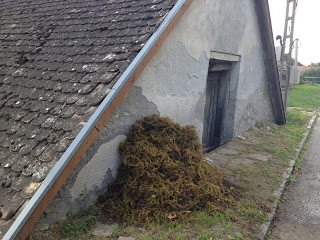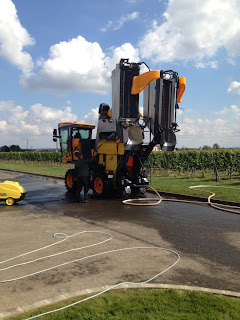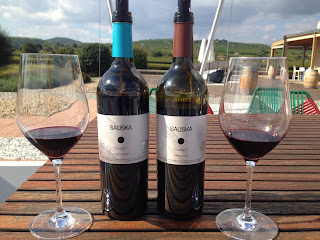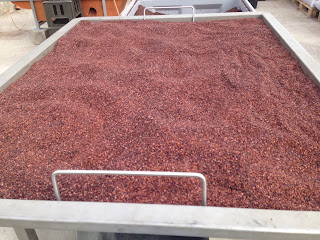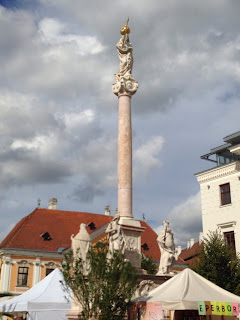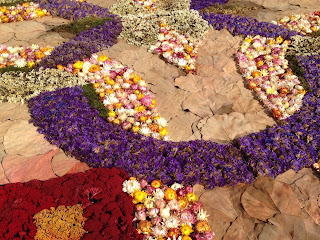A 50 minute train ride
from Villany to Pecs, a bus out of Pecs, and an hour and a half later I am
in Szekzard, one of the notable wine regions of Hungary. I use my
‘new’ app, called ‘maps.me,’ for directions to my lodging, a little over a
mile away. No problem. The route starts out flat, and
then the gradient proceeds to steepen - a lot. No choice but to
continue onward, toting my Rick Steve’s soft luggage with back straps and
my Champion backpack.
By the time I reach the
Koroza Guesthouse, I am bushed. But wait. The door is
locked. A sign in several languages is affixed to the door.
The English portion reads ‘if you are not here call this phone number'.
That sign tells me two things. It is likely that the owner’s
English is practically nonexistent, and, I am screwed since I need Wi-Fi
to make a call. However, I find myself smiling at the sign's wording
and thinking about the sound of one hand clapping.
I sit on the steps and
wait half an hour. No one shows up. A car pulls up to the
curb. It turns out to be the neighbor across the
street. I ask her if she will call. She calls - her
husband - who comes over and makes the call. He tells me it is not
the first time this has happened.
The landlady shows up 15
minutes later. It is not uncommon for folks here not to know
English, and she is one of those folks. She explains about the room,
the kitchen, etc. very nicely, in Hungarian. I
nod. Thankfully, from having stayed in upwards of a dozen places by
now, I get the gist of what she is saying. I pay, she bids me good
day after giving me a map of the area and the Wi-Fi code, and leaves.
It is late afternoon by
now and time to go to a small grocery to stock a few supplies, then head to a
nearby restaurant for dinner.
On the way I see two
people making wine. One is pressing grapes in a cellar that is open
to the street. The other has a portable augur on a trailer hitch and
is feeding risling grapes into it out of the back of his station
wagon. I ask what grape the two fellows in the cellar are pressing. No
English, but it does get me a glass of red wine. Nice, light and
fruity. Makes me think it is PortaGeza.
Here is a picture of the
grape vines piled up against the building where they were running the risling
through the portable augur.
The next day it
was off to Fekete vineyards to taste their wine. Again maps.me
showed me the way – which turned out to be up and down two
mountains. If I were to suggest one improvement to the app it would
be to give a poor unsuspecting soul an idea of the elevations to be traversed
using their recommended route. This is just one of the climbs up the first mountain on the
way to the vineyard.
A reward for my huffing
and puffing up to what was no doubt the highest pinnacle in the area was a of a
sculpture of grape vines, leaves and clusters, and view over the city.
Finally half way down
the second mountain I reached the winery. I was met by the wife who spoke no
English. After a minute of miscommunication she summoned her husband
who was also ‘Englishless’’. I used my trusty Google translator to
explain that I wanted to taste their wines starting with their Cabernet
Sauvigon Selection 2011 that won a gold medal in the 2014 Challenge du vin held
in Bordeaux, France.
Out came a new bottle
which he uncorked and poured. I should have let it sit for a while
before tasting to get the full benefit of bouquet and
flavor. However a sip out of the glass a minute or two after it was
poured revealed a lovely slightly dry Cabernet.
Then came other award
winning wines, a rose which is on the wine list of one of the Budapest
Michelin starred restaurants. As delightful as a rose could
be. Then came a shiller which is a relative of a rose but the skins
are left in longer and the wine develops a red color between a rose and full
red wine.
There was a show
stopping 2009 Chardonnay done in oak.
Somewhere during the
tasting he got up from the table and made a phone call. A young lad
and his father subsequently drove up. The young man in his teens
spoke English. Conversation through interpretation flowed smoothly
after that.
After tasting a several
more wines I said I would come back the next day to purchase some. I
tried to pay for the tasting but he would not accept any money.
Here are some tasting
notes and more photos.
Fekete winery
Cabernet Sauvignon
2014 challenge
international
France gold medal
Light bouquet
Slightly dry and claret-
like
2015 rose
Cuvee
70% blue Frankish
30% !???
Light bouquet
Refreshing
Faintly tart
Delicious
Schiller Kadarka 2014
Dark rose
The best
Kadarka Schiller I have drunk on my trip.
Chardonnay 2014
In oak
Mild oak bouquet
Delicious wine
White Kadarka
(made from a red grape,
but the skins do not come in contact with the grape juice)
Clear white wine
Delicious flavor
Kadarka 2011
Ripe berry bouquet
Very dry red wine
The young fellow who
spoke English told me to go a much better way back. It involved a ten
minute walk down a steep road to an intersection with a bus stop.
Here is the reward for
my hard day's labor:
